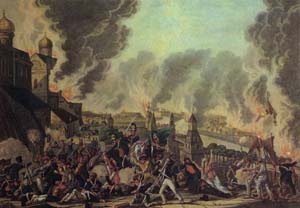|
|||
|
Philatelia.Net / Bonapart / Plots / The directory «Plots of stamps in the catalogue»MoscowThe 19th century brought with it tragic times for Moscow. On September 2, 1812, French troops took the city and Napoleon tried to establish his residence in the Kremlin. Two French regiments were quartered in the Senate building. When the French began their retreat, Napoleon gave orders to blow up the Kremlin. Mines were laid beneath many of the Kremlin buildings and towers. But the effort, entrusted to Marshal Mortier, was only a partial success because the night brought heavy rain that dampened the burning fuses, while some of them were noticed and extinguished by vigilant Muscovites. Nonetheless, parts of the Kremlin were seriously damaged. The biggest of the five explosions that went off was the first, which blew out all the glass and even the window frames in the Kremlin and neighboring buildings. The Vodozvodnaya Tower was entirely demolished and the Nikolskaya Tower was half destroyed. Parts of the Arsenal were destroyed, and the Faceted Palace, the Filaret Annex and the Commandant’s building were all damaged. The palace walls and the Armory building were left blackened by the flames. The Kremlin cathedrals also suffered substantial damage. During the fire, the Senate building was also damaged and the bronze St. George that had graced the dome of its Round Hall disappeared without a trace. One version of the story said the sculpture melted in the flames; according to another, the French army removed it, along with two other objects that were the Kremlin’s pride – an eagle from the Nikolsky Gates and a cross from the Ivan the Great Bell Tower – and took them as war trophies. When he heard about the fire in Moscow, architect Matvey Kazakov, then 72 years old and living out his last days in Ryazan, fell into despair. “This news was a fatal blow to him,” wrote his son. “Having devoted his entire life to art, beautifying the imperial city with magnificent buildings, he could not imagine without shuddering that his many years of labor had been reduced to ash and disappeared together with the smoke from the fires.” The city threw itself into raising its former glory from the ashes and ruins with so much energy that contemporaries said people were not merely restoring Moscow, but founding it anew for the third time. Large-scale restoration work went on above all in the Kremlin. Though war had considerably drained the state coffers, Tsar Alexander I (1801-1825) worked hard to restore the Kremlin’s towers, walls, palaces and cathedrals. He often came to Moscow to see for himself how the work was going. The best architects of the time had been called in for this ambitious job. Osip Beauvais rebuilt the top of the Nikolskaya Tower and restored the Arsenal. Carlo Rossi rebuilt the church in the Voznesensky Convent and Domenico Gilardi restored the cathedral belfry. Gradually, the Kremlin was restored to order. Gardens were laid out along its exterior, and were subsequently called the Alexandrovsky Gardens. The Senate was also restored to its original appearance and various state departments and agencies -- such as the Kremlin delivery service, the Boundaries Office, the treasuries, two archives, the Commission of the Provisions Depot and the Auditing Department -- moved back into the building. The Senate’s Sixth, Seventh and Eighth Departments also moved back into the building. The Defense Ministry installed its archives and one of its departments in the building’s Round (Catherine) Hall. It was only under Nicholas I (1826-1855) that the damage caused by the 1812 fire was fully repaired. Nicholas I paid particular care to having the ancient Kremlin churches and other old buildings restored. It was during his reign that restoration of the Arsenal was completed. He had cannons captured from Napoleon’s army placed along the Arsenal’s walls as trophies. Also during his time, a new Armory building was constructed on the site of the royal stables, and state treasures and all sorts of antique objects were moved there. Also built was the Cavaliers’ Building, which housed palace servants. Yemen (Kindom), 1970, General Bonaparte at the Conseil des Cinq-Cents Advertising: |
|||
© 2003-2025 Dmitry Karasyuk. Idea, preparation, drawing up
|

